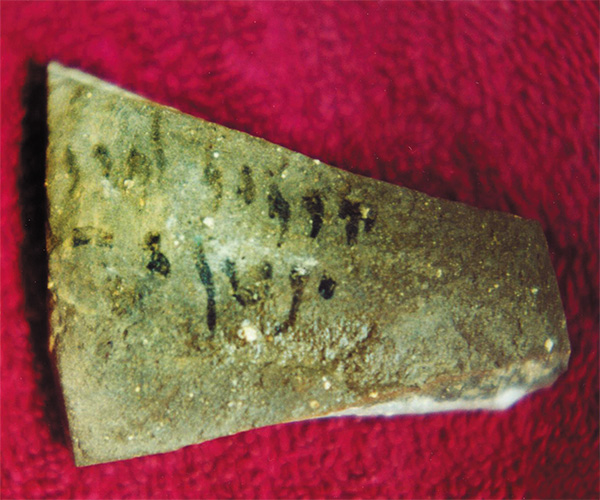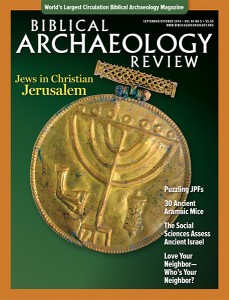2,000 Ancient Aramaic Business Scribbles (including the delivery of 30 mice)
Once a week I drive from Jerusalem to my daughter’s. She lives in Shoham, a little town near Ben Gurion Airport on the highway to Tel Aviv. In just a half hour, the mountains of Jerusalem gradually give way to open plains. Most of the fields here are cultivated. The color of the fields changes according to the season. At the end of winter, one can see the furrows in the brown fields. The color then becomes pale green with the sprouting in spring. Next comes the golden stubble at the beginning of summer. In late June and July, after the harvest, sheaves of straw lie scattered in the fields and disappear a short time afterward.

At this time I often think of the fourth-century B.C.E. Aramaic ostraca recording the delivery of grains in the late spring and summer, to which I have devoted more than a decade of my professional life. These are broken pieces of pottery with inscriptions on them, written in black ink by scores of scribes.

There are about 2,000 of them! Aramaic was the language Jews brought back with them from the Babylonian exile, and this was the language Jesus would speak several hundred years later. More specifically, most of the ostraca date to the second half of the fourth century B.C.E. They come from the area known as Idumea, about 35 or 40 miles southwest of Jerusalem. They mainly record the delivery of wheat, barley and straw. Many of them bear dates, specifying the number of the day, month (the Babylonian name) and year of the reign of the ruler, whose name occasionally also appears. The rulers are the Persian monarchs Artaxerxes II and III, the Hellenistic Philip (Arrhideus), Alexander VI, the usurper Antigonus (who interrupted Alexander’s rule several times), and Ptolemy (just once), who declared himself king in 305 B.C.E.
At this time Judea and Idumea were satrapies of the Persian empire which in 333 B.C.E. surrendered to the Macedonian commander Alexander III (“the Great”), marking the beginning of the Hellenistic period.
The precise provenance of about 1,760 of these ostraca is unknown. The rest come from authorized excavations, including Beer-Sheva and Maresha (Marissa). The unprovenanced ostraca appeared on the antiquities market by means of Bedouin who found them through unauthorized diggings. The Bedouin sold them to antiquities dealers, who then sold them to collectors in Israel and abroad. Some of the ostraca were donated to museums and institutes.
The largest collection in this corpus now belongs to David and Jemima Jeselsohn of Zurich. They have more than 500 ostraca in their collection. The Institute of Archaeology of Hebrew University has more than 430. Another large collection, more than 370 ostraca, belongs to the well-known Israeli collector Shlomo Moussaieff.a The Israel Museum in Jerusalem has about 220, and the Bible Lands Museum in Jerusalem has another 50 or so. The Jewish Theological Seminary in New York has 24 more. Another 100 are in the collection of Prof. Yigal Ronen of Beer-Sheva. The Israel Antiquities Authority in Jerusalem has about 11, confiscated from dealers. Small groups or a single ostracon are in about 20 or more private collections in Israel and abroad.
These texts provide important evidence of agricultural and clerical practices as well as of the ethnic composition of the population of the Hebron hills at this time. The area was part of Idumea, which had already been settled by Edomite invaders in the early sixth century B.C.E. when the former, mainly Jewish, population had been exiled to Babylonia. The mixed population (mostly Edomites and Arabs) was engaged in agriculture. Many of the ostraca record quite precisely the delivery of products to and from the storehouses. Many people took part in this activity; about 600 different names appear in the texts.
This corpus of Aramaic ostraca from Idumea can be divided into six main groups:
1. Records of the delivery of products. This comprises the majority of texts.
2. Records of the delivery of workers (about 70 ostraca).
3. Lists of land parcels (more than 100).
4. Inscriptions on jars (about 60).
5. Account lists of various kinds (about 30).
6. Letters (fewer than 20, all fragmentary).
In addition to these six groups, various other kinds of texts appear on single or small groups of ostraca, such as a memorandum concerning a debt of barley.

The main products are wheat and barley with different kinds of grinding that bear different names. A kind of excellent flour, perhaps referring to semolina, is twice the value of ordinary flour. These products are measured with the capacity measures kor, se’ah (30 in a kor) and qab (six in a se’ah).
Other products include food for animals, such as straw (
About 70 texts record the delivery of oil, apparently olive oil. Wine (measured by capacity measures) appears in 10 or 15 texts. The Aramaic word for wine is spelled the same as the name for donkey (counted by units); thus five texts in which the measures are missing may refer either to wine or to donkeys.
Other texts record the delivery of wood and various wood products, such as beams, boards and logs. The wood products are measured in units or in loads (Aramaic
A few records relate to the delivery of hides (

Perhaps these ostraca were part of the royal accountancy, first the Persian and then the Hellenistic authorities that ruled the area. About ten texts include instructions to deliver certain products. One of the texts contains the Babylonian name of the person who issued the instructions (Beldalani—
Almost 600 personal names appear in the ostraca. About a hundred of them are Edomite, as indicated by the name kos (spelled qws—
In the few cases referencing women, their names are not given; they are identified only as the wife or daughter of the man.
Families, or clans, seem to have played an important role in the population. Many of the people are identified (in addition to their patronymic) by the name of the head of the clan—for example, “from the sons of” or “from the house of.” The names of the large clans appear in dozens of texts, the largest clans being Baalrim, Gur, Qotsi, Yehokal and Alibaal. Most of the workers belonged to these clans.
Some of the individuals mentioned by name deliver products, others receive products, while still others are agents—another indication of a relatively complex economic structure. The agents or middlemen apparently bought products at the instruction of the supplier and delivered them to the recipient. In addition to the suppliers, recipients and agents, other people appear in many records as signatories at the end of the texts, possibly confirming the transactions.
In about 50 ostraca, the word for storehouse (maskanta—
More than half of the ostraca have already been published, mainly by Hebrew University scholars Israel Eph’al and the recently deceased Joseph Naveh, as well as by André Lemaire of the Sorbonne. A new collation of all these texts has yielded hundreds of new readings and many corrections. For some 14 years now, Bezalel Porten of Hebrew University and I have been preparing this corpus for publication. The first volume is already out. We have also published several articles dealing with various aspects of the ostraca.
We have devoted all this effort to these Aramaic ostraca despite the fact that they are unprovenanced. They were undoubtedly looted by Bedouin before coming onto the antiquities market. The fact that the texts reflect the work of scores of scribes and the fact that some of these texts are by the same scribe who wrote on an ostracon that was recently found in the excavations in Maresha support beyond any doubt the authenticity of these texts. Those objecting to the publication of unprovenanced inscriptions should ask themselves if this material, which sheds light on many aspects of daily life in this area in this period—vastly enriching our knowledge—should be hidden or buried. I think it would be a huge mistake to ignore the information revealed by these texts.

